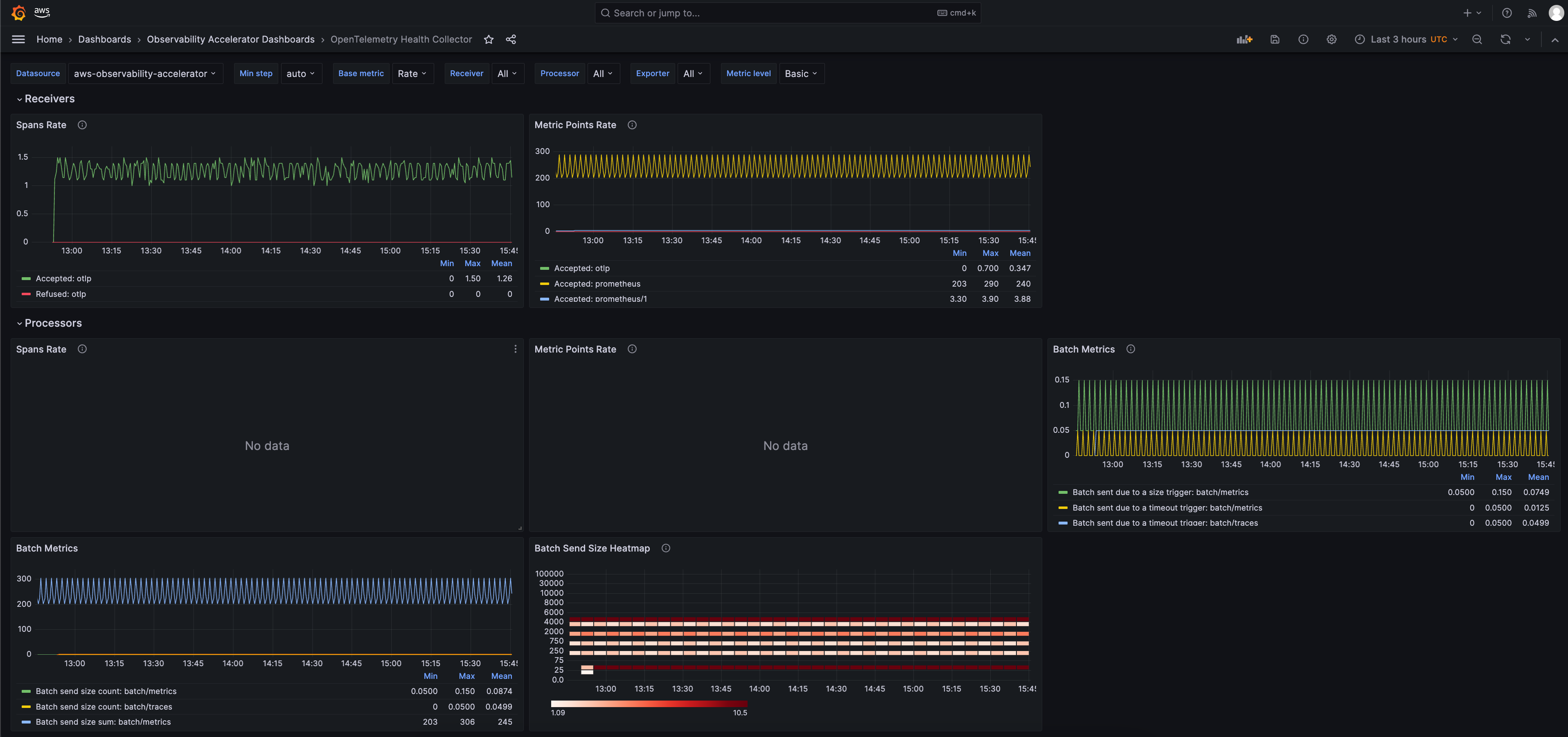Single Cluster Open Source Observability - OTEL Collector Monitoring¶
Objective¶
This pattern demonstrates how to use the New EKS Cluster Open Source Observability Accelerator with monitoring for ADOT collector health.
Prerequisites¶
Ensure that you have installed the following tools on your machine.
Deploying¶
Please follow the Deploying instructions of the New EKS Cluster Open Source Observability Accelerator pattern, except for step 7, where you need to replace "context" in ~/.cdk.json with the following:
"context": {
"fluxRepository": {
"name": "grafana-dashboards",
"namespace": "grafana-operator",
"repository": {
"repoUrl": "https://github.com/aws-observability/aws-observability-accelerator",
"name": "grafana-dashboards",
"targetRevision": "main",
"path": "./artifacts/grafana-operator-manifests/eks/infrastructure"
},
"values": {
"GRAFANA_CLUSTER_DASH_URL" : "https://raw.githubusercontent.com/aws-observability/aws-observability-accelerator/main/artifacts/grafana-dashboards/eks/infrastructure/cluster.json",
"GRAFANA_KUBELET_DASH_URL" : "https://raw.githubusercontent.com/aws-observability/aws-observability-accelerator/main/artifacts/grafana-dashboards/eks/infrastructure/kubelet.json",
"GRAFANA_NSWRKLDS_DASH_URL" : "https://raw.githubusercontent.com/aws-observability/aws-observability-accelerator/main/artifacts/grafana-dashboards/eks/infrastructure/namespace-workloads.json",
"GRAFANA_NODEEXP_DASH_URL" : "https://raw.githubusercontent.com/aws-observability/aws-observability-accelerator/main/artifacts/grafana-dashboards/eks/infrastructure/nodeexporter-nodes.json",
"GRAFANA_NODES_DASH_URL" : "https://raw.githubusercontent.com/aws-observability/aws-observability-accelerator/main/artifacts/grafana-dashboards/eks/infrastructure/nodes.json",
"GRAFANA_WORKLOADS_DASH_URL" : "https://raw.githubusercontent.com/aws-observability/aws-observability-accelerator/main/artifacts/grafana-dashboards/eks/infrastructure/workloads.json",
"GRAFANA_ADOTHEALTH_DASH_URL": "https://raw.githubusercontent.com/aws-observability/aws-observability-accelerator/main/artifacts/grafana-dashboards/adot/adothealth.json",
"GRAFANA_KSH_DASH_URL" : "https://raw.githubusercontent.com/aws-observability/aws-observability-accelerator/main/artifacts/grafana-dashboards/eks/infrastructure/ksh.json",
"GRAFANA_KCM_DASH_URL" : "https://raw.githubusercontent.com/aws-observability/aws-observability-accelerator/main/artifacts/grafana-dashboards/eks/infrastructure/kcm.json"
},
"kustomizations": [
{
"kustomizationPath": "./artifacts/grafana-operator-manifests/eks/infrastructure"
},
{
"kustomizationPath": "./artifacts/grafana-operator-manifests/eks/adot"
}
]
},
"adotcollectormetrics.pattern.enabled": true
}
Visualization¶
The OpenTelemetry collector produces metrics to monitor the entire pipeline.
Login to your Grafana workspace and navigate to the Dashboards panel. You should see three new dashboard named OpenTelemetry Health Collector, under Observability Accelerator Dashboards
This dashboard shows useful telemetry information about the ADOT collector itself which can be helpful when you want to troubleshoot any issues with the collector or understand how much resources the collector is consuming.
Below diagram shows an example data flow and the components in an ADOT collector:

In this dashboard, there are five sections. Each section has metrics relevant to the various components of the AWS Distro for OpenTelemetry (ADOT) collector :
Receivers¶
Shows the receiver’s accepted and refused rate/count of spans and metric points that are pushed into the telemetry pipeline.
Processors¶
Shows the accepted and refused rate/count of spans and metric points pushed into next component in the pipeline. The batch metrics can help to understand how often metrics are sent to exporter and the batch size.

Exporters¶
Shows the exporter’s accepted and refused rate/count of spans and metric points that are pushed to any of the destinations. It also shows the size and capacity of the retry queue. These metrics can be used to understand if the collector is having issues in sending trace or metric data to the destination configured.

Collectors¶
Shows the collector’s operational metrics (Memory, CPU, uptime). This can be used to understand how much resources the collector is consuming.

Data Flow¶
Shows the metrics and spans data flow through the collector’s components.

Note: To read more about the metrics and the dashboard used, visit the upstream documentation here.
Disable ADOT health monitoring¶
Update the context in cdk.json file located in cdk-eks-blueprints-patterns directory
"context": {
"adotcollectormetrics.pattern.enabled": false
}
Teardown¶
You can teardown the whole CDK stack with the following command:
make pattern single-new-eks-opensource-observability destroy